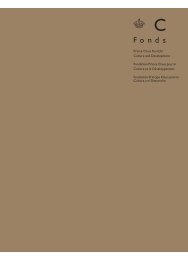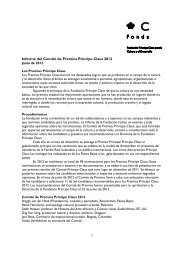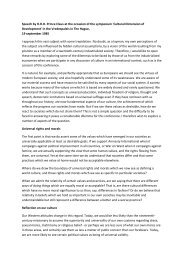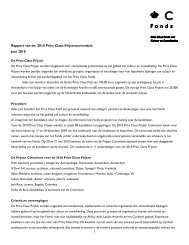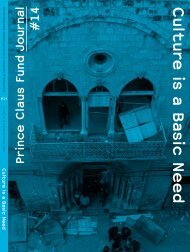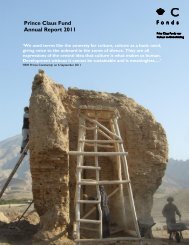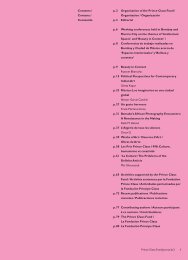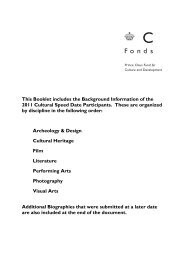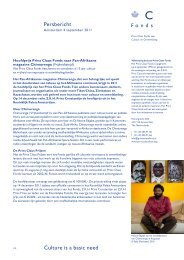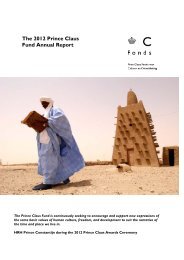3 summer 2011 - Prince Claus Fund
3 summer 2011 - Prince Claus Fund
3 summer 2011 - Prince Claus Fund
- No tags were found...
You also want an ePaper? Increase the reach of your titles
YUMPU automatically turns print PDFs into web optimized ePapers that Google loves.
030–053talattekin_alt:turklergaram 29.11.2007 9:21 Uhr Seite 35Yenisei inscriptions, sixthcentury. MinusinskMuseum, Minusinsk,Russia (cf. pp. 30, 32).10. The formation of the aorist (indefinite) by the additionof -(a)r/-(ä)r, and of the present tense by the addition of -ır/-ir, -ur/-ür: çıx-ar “(he) goes out,” çıx-ır “(he is) going out,”ged-är “(he) goes,” ged-ir “(he is) going out,” oxu-r “(he) reads,”oxu-yur “(he is) reading”: çıx-ar “go out,” çıx-ır “going out,” gedär“go,” ged-ir “going,” oxu-r “read,” oxu-yur “reading.”Azeri Turkish is very similar to Turkish, but the presenceof one or more words of unknown meaning can impede comprehensionof a sentence. The following are examples of sentencesof this type in Azeri Turkish: Avtobusa gabagdan bin, daldandüş “Enter the bus from the front, leave from the rear”;Köçädä maşın fit çaldı “The car sounded its horn in the street”;Yay gälmämiş havalar istiläşir “Although <strong>summer</strong> has not yetarrived, it is getting warmer”; Şamı eşikdä yiyäcäyik “We’ll go outfor our evening meal”; Gonaglardan biri kinoya zäng elädi “Oneof the guests phoned the cinema”; Atam paltarını çiyninä alıbbayıra çıxdı “My father threw his jacket over his shoulders andwent out.”The influence of Persian syntax can be observed in AzeriTurkish. For example, the Azeri Turkish beş il bundan gabag,meaning “five years ago,” is in the nature of Persian pänc sa:lpi:ş äz i:n.C. The Turkmen and Their LanguageThe term Turkmen (or Turcoman) first appears in theMahmut Kashgarl› dictionary, which has the name Turkmen assynonymous with the ethnic term Oghuz. The Turkmen aredescendants of the Oghuz Turks, who remained in their owncountry rather than migrating to the West. The Turkmen languageis thus the sole representative of the Eastern branch ofthe Oghuz group of Turkic languages. (The Western branch ofthe Oghuz group consists, as we have seen, of Azeri Turkish,Turkish, and Gagauz Turkish.)The “Turkmene” (Oghuza) words are first encountered inthe dictionary produced by Mahmut Kashgarl› and in the dictionariescompiled by fourteenth-century Arab linguists; thefirst literary texts were produced in the seventeenth, eighteenth,and nineteenth centuries by Turkmen poets, such as Andelib,Mahdumkul› (Turkmen Magt›mgul›), and Mollanepes. Turkmenonly became an official written language after the Soviet revolution.Until 1928, it was written in the Arabic script; from 1929to 1939, it was in the Latin alphabet. Since 1939, it has beenwritten in Cyrillic script.Nowadays, Turkmen is spoken mainly in the Republic ofTurkmenistan, but there are also Turkmen-speaking communitiesin Uzbekistan, the Karakalpak Autonomous Province, theRepublics of Kazakhstan and Tajikistan, and the Stavropolregion of the Russian Federation. According to the 1989 census,the number of Turkmens in the former Soviet Union was2,718,297. Adding the Turkmens living in Iran (590,000),Afghanistan (330,000), Iraq and Syria (5,243,000), and Turkey(92,000) produces a Turkmen-speaking community of approximately4 million. The Turkmens are Sunni Muslims.There are several dialects of Turkmen, which can be collectedin two large groups: (1) Teke, Yellow, Sal›r, Gökleng,Yomud, Ersar›, etc., (2) Nohur, Anav, Eski, Suhr›, Arabaj›, K›rach,Chand›r, Mukr›, Hatap, Bayat, and Cheges. To these should beadded the Trukhmen (= Turkmen) dialect spoken in theNorthern Caucasus and the Stavropol region, the KhorasanTurkmen spoken in Iran, and the Khwarezm Oghuz dialectsspoken in the Khwarezm region of Uzbekistan. In its display ofcertain features of Common Turkic, Turkmen occupies animportant place both in the Oghuz group and in Turkic languagesas a whole. In other words, Turkmen is in the nature ofa “key language.” The distinguishing features of Turkmen are asfollows:1. The most important feature of Turkmen is the systematicpreservation of the primary long vowels in CommonTurkic. The long /a:, ä:, ›:, i:, o:, ö:, u:/ vowels in Common Turkicare preserved intact in Turkmen, while the long /ü:/ is convertedto /üy/: a:t “name,” ä:r “man, husband,” *kı:z > gı:z “girl,” i:ş“work,” o:t “fire,” *tö:rt > dö:rt “four,” bu:z “ice”; but *kü:ç >*güyç “power, strength,” *kü:z > güyz “autumn,” süyt < *sü:t“milk,” etc.2. The long closed /e:/ in Proto-Turkic normally takesthe form of long /i/ in Turkmen: *be:l > bi:l “back,” *e:r > i:r“early,” *e:şik > i:şik “door,” *ke:ç > gi:ç “late,” *ye:t- > i:t- “tolead,” etc.3. In the two following words, the long closed /e:/ inProto-Turkic takes the form /iy/ in Turkmen: *te:- > diy- “to say,”*ye:- > iy- ?to eat.” The postvelar /q/ at the beginning of a wordis replaced by the /k/, and front /k/ sounds are replaced byback and front /g/ sounds. In this respect, Turkmen displays aproximity to Azeri: ga:l- “to stay” = Az. gal-, gatı “hard, solid” =Az. gatı, gı:z “girl” = Az. gız, gıssan- “to envy” = Az. gısgan-,gork- “to be afraid” = Az. gorh-, gu:rı “dry” = Az. guru, etc.4. The /t/ sound at the beginning of a word changes to/d/, as in Turkish and Azeri. In this, Turkmen is more advancedthan Turkish: da:ban “floor,” da:ş “stone,” dak- “to put on,” darak“comb,” dep- “to kick,” dık- “to cram (into),” du:z “salt,” etc.5. An important feature concerning vowels in Turkmenis the labial attraction also found in Kirghiz. This consists of therounding of flat vowels in following syllables under the influenceof rounded vowels in the first syllable (this rounding is notreflected in the written language): oğlak (oğlok), oğlan (oğlon),oğlanlar (oğlonlor), buzav (buzov) “calf,” çörek (çörök), kömelek(kömölök) “mushroom,” dümev (dümöv) “flu,” etc.6. Another feature of Turkmen is the conversion of /s/and /z/ sounds into interdental /s/ and interdental /z/: sa:z, söz,sız- “to ooze,” süz-, suv “water,” dessa:n “epic,” ussa:t “master,”gızzırma “malaria,” etc.7. Yet another characteristic feature of Turkmen is theconversion of the /a/ or /i, ü/ vowels at the end of a verb into/e/: okı- > oka- “to read,” *ba:yu- > ba:ya- “to be rich,” sämri-> semre- “to grow fat,” törü- > döre- “to happen,” etc.8. Another feature common to both Turkmen and AzeriTurkish is the conversion of the /k/ consonant into /g/: AT *ka:l-> ga:l-, AT *kı:z > gı:z, etc.9. The present-tense suffix from -a yorur in O€uz, > -ıyor/-iyor < in Turkish, and -ır/-ir in Azeri takes the form -ya:r/-yä:r in Turkmen: bar-ya:r “(he is) going,” gel-yä:r “(he is) coming,”oka-ya:r “(he is) reading.” Even though Turkmen is theclosest Turkish language to Turkish after Azeri, the mutual intelligibilityratio between Turkish and Turkmen is fairly low.A few sentences in Turkmen: Parahot tolkunları bövsüpbarya:r “The ship sails on through the waves”; Ca:yıng bina:sıPRESENT-DAY TURKIC PEOPLES AND THEIR LANGUAGES3545 · <strong>Prince</strong> <strong>Claus</strong> <strong>Fund</strong> Reader #3 · Summer <strong>2011</strong>



